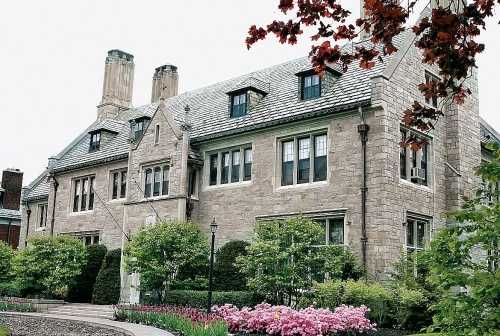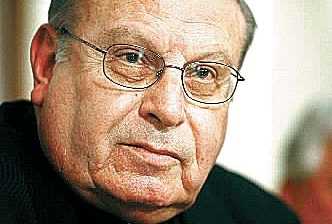Mansion's Opulence Criticized in a Time of Diocesan Downsizing
By Jay Tokasz
Buffalo News
May 19, 2007
http://www.buffalonews.com/home/story/79189.html
A priest first raised the issue publicly nearly 20 years ago, when he asked at a conference of clergy why his bishop needed to live in a mansion on one of the city's most exclusive streets.
Now, the question is arising again in the Diocese of Buffalo, especially among Catholics concerned about the closing of area churches and schools.
Some Catholics are suggesting that Bishop Edward U. Kmiec sell the 11,000-square-foot stone mansion at 79 Oakland Place and use the profits to assist struggling schools and parishes, instead of shutting them down.
The E.B. Green-designed house has nine bedrooms and six bathrooms. Kmiec lives there along with his secretary, the Rev. David G. LiPuma, and the diocesan chancellor, the Rev. Paul A. Litwin.
Diocesan officials this week said the mansion serves a crucial role and is much more than a residence.
 |
| Its ostentatious to the point of being insulting to the parishioners of this diocese. Craig E. Speers, St. Rose of Lima parishioner Photo by Sharon Cantillon |
"It's used extensively for pastoral meetings, as well as social functions," said diocesan spokesman Kevin A. Keenan. "We see great value in maintaining this residence as a base of operations ... There's no other place like this where [the bishop] can conduct the kind of business that's conducted there."
A variety of dinners and fundraising efforts for Catholic Charities and Catholic education are held in the mansion, as well as meetings with priests, dignitaries, and visiting bishops, who receive overnight accommodations.
The building saves the diocese the expense of renting hotel, restaurant or conference room space for many of the events and visits, Keenan said.
But some view the living arrangement as a luxury during a time when many Catholics are being asked to give up the churches that have been their spiritual homes for their entire lives.
"It should be, 'Practice what you preach,' " said Catherine Keogh, a parishioner of St. John the Baptist Parish in the Town of Tonawanda. "He doesn't need it. That's the bottom line. It's a waste."
After Keogh learned that Catholic Charities would no longer fund the Society of St. Vincent de Paul summer camp, putting the camp's future in jeopardy, she wrote a letter to The News calling on the bishop to sell or lease both the mansion and the Catholic Center at 795 Main St.
 |
| Bishop Edward U. Kmiec We see great value in maintaining this residence as a base of operations
Kevin A. Keenan, diocesan spokesman |
"It's always the kids who suffer. It's just not right," she said.
Craig E. Speers, a parishioner of St. Rose of Lima Parish in North Buffalo, followed up with the same request.
"It's ostentatious to the point of being insulting to the parishioners of this diocese," Speers said in reference to the mansion and the Main Street diocesan headquarters.
"They're not religious buildings. They have no religious significance," he said.
Speers began raising his objections following the bishop's decision earlier this year to close St. Rose of Lima parish school and 13 other schools.
In 1987, a Buffalo priest created a stir in the diocese by suggesting the bishop could do without the Oakland Place mansion.
At a conference in a downtown hotel, local Catholic clergy were discussing how they might best respond to Pope John Paul II's statement at the time on the church's "preferential option for the poor."
The Rev. Roy Herberger asked if they might begin by selling the diocesan mansion and living in simple quarters, as a way to be more in sync with Catholic social teaching.
"There was quite a reaction," said Herberger, who is now pastor of St. Columba & St. Brigid Parish.
Lay people concerned
Bishop Edward Head responded then in a Buffalo News story that he had considered changing residences when he first arrived in Buffalo in 1973, but decided to stay because moving wasn't practical.
Herberger's statement "had a lot more meaning" back then because of what the priests were discussing, he said, but his beliefs on the subject haven't changed.
"I still stand by it, sure," he said.
Although the mansion hasn't been a source of conversation among clergy in more recent years, Herberger said he understood why it has become an issue among lay people, who will be making great sacrifices in giving up churches and schools.
"Wouldn't it be also very significant for the bishop and those who reside in the residence on Oakland to say, 'Yeah, we're serious, we want to help out, too?' " Herberger said.
Across the country, many Catholic bishops live in large homes for the purposes of accommodating visitors and hosting fundraisers. But there is precedence for moving out of the bishop's residence.
As archbishop of Cincinnati in the early 1970s, the Rev. Joseph Bernardin sold the diocesan mansion and moved into a three-bedroom apartment at the seminary. Bernardin later went on to become a cardinal and archbishop of Chicago. He died in 1996.
In 1981, Bishop Kenneth Untener sold the Diocese of Saginaw, Mich., mansion and spent the rest of his episcopacy, 24 years, living with fellow priests in rectories throughout the diocese.
More recently, Cardinal Sean O'Malley, the archbishop of Boston, sold the opulent archdiocesan residence and other property in Brighton to Boston College for $99.4 million, proceeds that were used to pay a settlement of cases involving the sexual abuse of minors by clergy.
Boston residence sold
O'Malley, a Capuchin priest who took a vow of poverty, has lived since 2004 in the rectory of the Cathedral of the Holy Cross, in the South End of Boston.
Although there are no plans currently to sell 79 Oakland Place, the bishop "would not rule out" that possibility as the diocese forges ahead with its reorganization efforts, Keenan said.
Some Catholics have suggested for years that the bishop move into the rectory of St. Joseph Cathedral, the central church of the diocese and home of the bishop's chair.
Until the early 1950s, Buffalo bishops had lived at 1035 Delaware Ave., the former Knox House, near the diocese's former cathedral. The house now serves as rectory of Blessed Sacrament Parish.
The diocese purchased the Oakland Place home in 1952. Bishop Joseph Burke was the first prelate to live in the house.
A decade ago, assessed at $1.1 million, the Oakland Place mansion was the most valuable home in the entire city and the only residential property in Buffalo worth $1 million or more, according to city assessment records. That has changed since a citywide revaluation in 2002.
The house currently is assessed at $970,000, but it is exempt from property taxes because it is owned by a religious entity.
The diocese, which has an operating budget deficit of $2.1 million this year, so far has announced the merger of 11 parishes into five, with several church buildings slated to close.
Dozens more mergers and closures are anticipated as part of "Journey in Faith & Grace," a diocesan-wide restructuring effort to confront a growing priest shortage, shore up parish and diocesan finances, and reinvigorate worship in area churches.
Savings on maintenance
In addition to the real estate profits, the diocese would realize savings on utilities and maintenance costs by selling the mansion and the Catholic Center, said Speers.
"Put that money where it belongs, in the parish communities," he said.
But Keenan said the diocese would have to house its business operations somewhere, and regardless of where, "you're going to have utility costs."
Contact: jtokasz@buffnews.com
Any original material on these pages is copyright © BishopAccountability.org 2004. Reproduce freely with attribution.